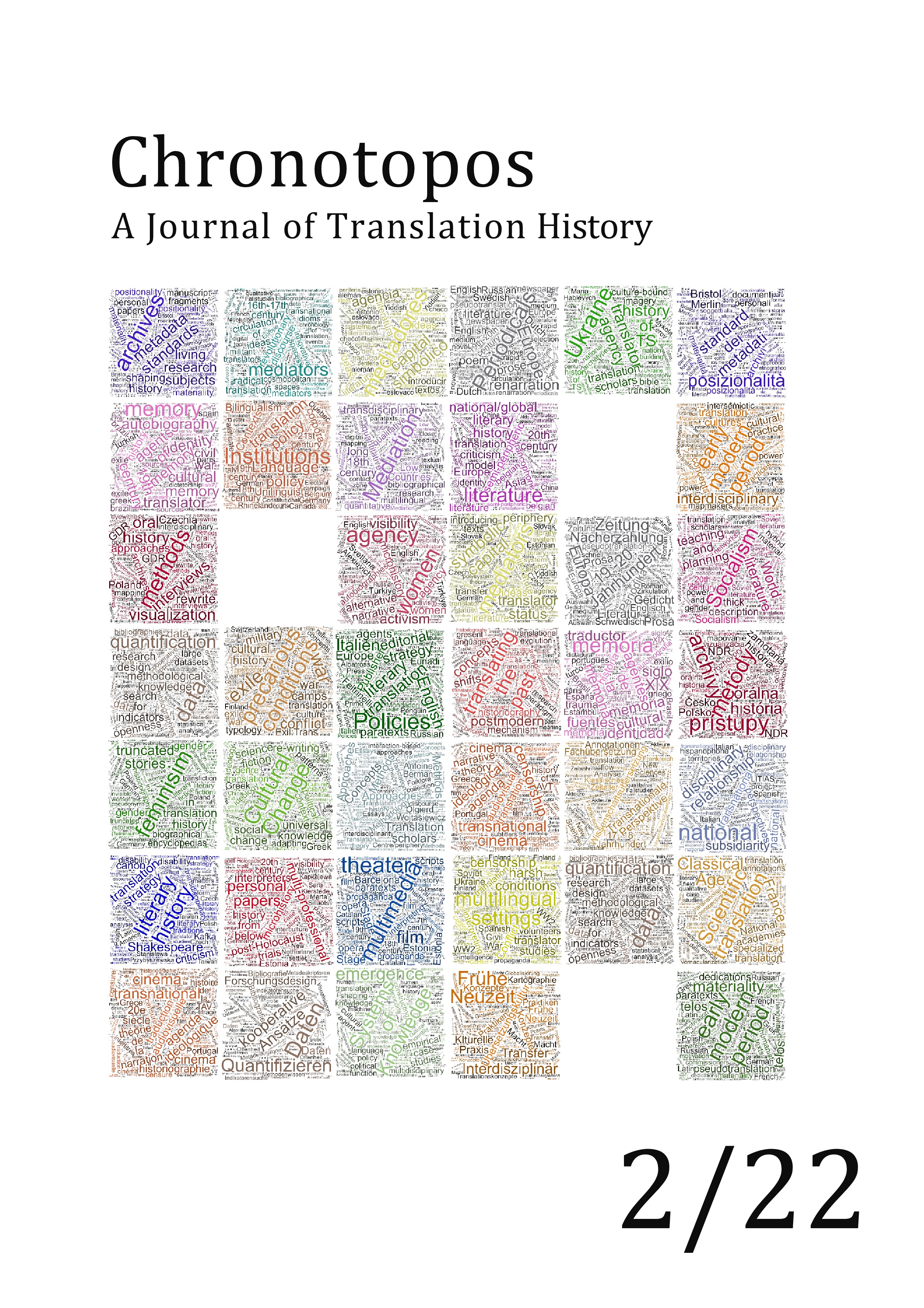Invisible Mediators: Interpreters of German Occupied Greece (1941–1944)
DOI:
https://doi.org/10.25365/cts-2022-4-2-3Keywords:
interpreters, World War II, gender, social class, Occupied Greece, ideologyAbstract
Recent years have seen the creation of a complex and multifaceted body of scholarly work examining the role of translators and interpreters in conflict situations. More is yet to be discovered, however, about these significant individuals and their functions and contribution to past and current wartime situations. Using data collected from oral histories gathered as part of the digital archive project by the Free University of Berlin, and the written testimonials provided by the Center for Neo-Hellenic Studies, this study focuses on the underexplored role of interpreters in German Occupied Greece (1941–1944). The digital archive offers key information regarding issues beyond what has been recorded so far regarding interpreter ethnic and ideological allegiances, for instance. Issues connected to the interpreters’ background, with a special emphasis on acquisition of linguistic skills, shed light on broader anthropological and sociological issues, such as their level of education, which may be linked to social class. Gender is another aspect discussed, as a result of the finding that a large number of interpreters in Occupied Greece were women.
This paper includes an annex with excerpts from testimonials (in Greek).
References
Primary sources:
http://www.snhell.gr/testimonies/writers.asp
https://www.occupation-memories.org/en/index.html
Secondary sources
ALEXIEVICH, Svetlana (2017): The Unwomanly Face of War. London: Penguin.
ANDRIANOPOULOS, Ioannis (2018): Η Ιταλογερμανική Κατοχή στη Μεσσηνία (1941–1944): Η αντίσταση ενός λαού [The Italian-German Occupation in Messinia (1941–1944): A people’s resistance]. Unpublished master’s thesis. University of Peloponnese. (26/07/2022).
APOSTOLOPOULOS, Nikolaos (2000): Μεσσηνιακή Εκτατόμβη 1940–1944 (1642 βιογραφικά Μεσσηνίων που θυσιάστηκαν για την πατρίδα την περίοδο 1940–1944) [Messinian Hecatomb 1940–1944 (1642 biographies of Messinians who sacrificed themselves for fatherland during the period 1940–1944]. Kalamata: ‘Eleftheria’ Newspaper Edition.
BAKER, Mona (2010): “Interpreters and Translators in the War Zone”, The Translator 16 (2), 197-222.
DE BERNIERES, Louis (1994): Captain Corelli’s Mandolin. London: Secker & Warburg.
ENCYCLOPEDIA BRITANNICA. https://www.britannica.com/topic/EAM-ELAS (02.04.2014).
DAVIES, Peter (2005): Dangerous Liaisons: Collaboration and World War Two. Harlow: Pearson Longman.
FOOTITT, Hilary (2010): “Another missing dimension? Foreign languages in World War II intelligence”, Intelligence and National Security 25 (3), 271-289.
FOOTITT, Hilary & KELLY, Michael (eds.) (2012): Languages and the Military: Alliances, Occupation and Peace Building. Basingstoke: Palgrave Macmillan
INGHILLERI, Moira (2009): “Translators in War Zones: Ethics under Fire in Iraq”. In: BIELSA, E. & HUGHES, C. W. (eds.): Globalization, Political Violence and Translation. Pal-grave Macmillan: London, 207-221. https://doi.org/10.1057/9780230235410_11.
INGHILLERI, Moira & HARDING, Sue-Ann (2010): “Introduction: Translating Violent Con-flict”, The Translator: Special Issue on Translation and Violent Conflict 16 (2), 165-174.
KOUNDOUROS, Roussos (1978): Η ασφάλεια του καθεστώτος. Πολιτικοί κρατούμενοι, εκτοπίσεις και τάξεις στην Ελλάδα, 1924–1974 [The regime’s security. Political de-tainees, displacements and social class in Greece, 1924–1974]. Athens: Kastaniotis Editions.
KOSKINEN, Kaisa (2012): “Domestication, foreignization and the modulation of affect”. In: KEMPPANEN, H.; JÄNIS, M. & BELIKOVA, A. (eds.): Domestication and Foreignization in Translation Studies. Berlin: Frank & Timme, 13-32.
KUJAMÄKI, Pekka (2014): “Interpreting for Generals: Military interpreters in Finnish propaganda photography”. In: FERNÁNDEZ-OCAMPO, A. & WOLF, M. (eds.): Framing the interpreter: Towards a Visual Perspective. Routledge: Oxon and New York, 128-139.
KUJAMÄKI, Pekka (2016): “‘And then the Germans came to town’: The lived experience of an interpreter in Finland during the Second World War”, Linguistica Antverpiensia, New Series: Themes in Translation Studies 15, 106-120.
MACKRIDGE, Peter & RICKS, David (eds.) (2018): The British Council and Anglo-Greek Literary Interactions, 1945–1955. Routledge: Oxon and New York.
MANOUSAKAS, Yannis (1975): Ακροναυπλία: Θρύλος και πραγματικότητα [Akronafplia: legend and reality]. Athens: Kapopoulos Editions.
MAZOWER, Mark (2001): Inside Hitler’s Greece: The Experience of Occupation, 1941–1944. New Haven and London: Yale University Press.
MUNDAY, Jeremy (2014): “Using primary sources to produce a microhistory of transla-tion and translators: Theoretical and methodological concerns”, The Translator 20 (1), 64-80.
NAKAMURA, Kelli (2008): “’They are our human secret weapons’: The military Intelli-gence Service and the Role of Japanese Americans in the Pacific War and in the Occu-pation of Japan”, The Historian 70 (1), 54-74.
NEMIROVSKY, Irene (2004): Suite française. Paris: Denoel.
PAPADEMETRIOU, Elli (2003): O κοινός λόγος, τρίτος τόμος [Common sense, Vol. 3]. Ath-ens: Hermes Editions.
PAVLENKO, Aneta (2007): “Autobiographic Narratives as Data in Applied Linguistics”, Applied Linguistics 28 (2), 163–188. https://doi.org/10.1093/applin/amm008.
PERRAKIS, Stylianos (2022): The improbable heroine: Lela Karayanni and the British Se-cret Services in World War II Greece. Berlin/Boston: De Gruyter.
RAFAEL, Vicente (2009): “Translation, American English and the National Insecurities of Empire”, Social Text 27 (4), 1-23.
RODRIGUEZ-ESPINOSA, Marcos (2016): “‘¡No Pasarán!’: Translators under siege and ideo-logical control in the Spanish Civil War”, Perspectives: Studies in Translatology, 24 (1), 22-35.
ROSENDO, Lucía Ruiz (2019): “Rethinking the interpreter’s agency in wartime: a por-trait of Gottlieb Fuchs”, The International Journal for Translation & Interpreting Re-search 11 (2), 58-68.
STEFATOS, Katherine (2011): “The Psyche and the Body: Political Persecution and Gen-der Violence against Women in the Greek Civil War”, Journal of Modern Greek Studies 29 (2), 251-277.
TAKEDA, Kayoko (2014): “The visibility of collaborators: Snapshots of wartime and post-war interpreters”. In: FERNÁNDEZ-OCAMPO, A. & WOLF, M. (eds.): Framing the inter-preter: Towards a Visual Perspective. Routledge: Oxon and New York, 150-160.
TAKEDA, Kayoko (2016): “Guilt, survival, opportunities, and stigma: Japanese inter-preters in the postwar occupation period (1945-1952)”. In: TAKEDA, K. & BAIGORRI-JALÓN, J. (eds.): New Insights in the History of Interpreting. Amsterdam/Philadelphia: Benjamins, 225-246.
THEOTOKAS, Yorgos (1964): Ασθενείς και Οδοιπόροι [The Sick and Traveler]. Athens: Es-tia Editions.
TORIKAI, Kumiko (2009): Voices of the Invisible Presence. Amsterdam/Philadelphia: Benjamins.
TRYUK, Małgorzata (2010): “Interpreting in Nazi concentration camps during World War II”, Interpreting: international journal of research and practice in interpreting 12 (2), 125-145.
TYMOCZKO, Maria (2003): “Ideology and the position of the translator: In what sense is a translator ‘in-between’?” In: CALZADA-PÉREZ, Maria (ed.): Apropos of Ideology: Trans-lation Studies on Ideology – Ideologies in Translation Studies Routledge: Oxon and New York, 181-202.
Downloads
Published
How to Cite
Issue
Section
License
Copyright (c) 2024 Nadia Georgiou

This work is licensed under a Creative Commons Attribution-NonCommercial 4.0 International License.

licence: CC BY-NC 4.0


